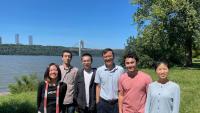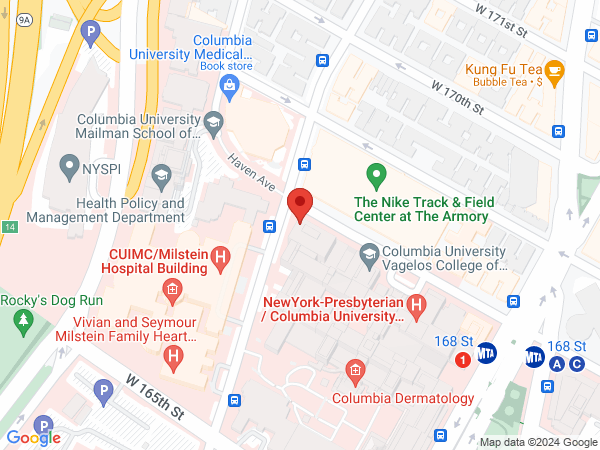Ding Lab

Location and Contact Information
Hematopoietic stem cells (HSCs) are rare, self-renewing cells that can generate the whole blood system throughout life. They are widely used in clinics to treat a number of hematopoietic disorders. But the rareness of HSCs has been hindering the safer and broader use of HSCs in clinics. Each year, thousands of lives cannot be saved through HSC transplantation due to the insufficient supply of HSCs. Despite decades of efforts, no culture systems are available to maintain and expand HSCs in vitro. Yet, in vivo, HSCs robustly self-renew. We believe that understanding the microenvironmental niche in vivo is the key to solving this unmet medical challenge. In the lab, we are focusing on elucidating the niche mechanisms that maintain HSCs in homeostasis and expand HSCs during development using genetically modified mouse models. As the bone marrow niche is increasingly appreciated as an important contributor to hematopoietic diseases, we also study the niche mechanisms in hematopoietic malignancies.
The Bone Marrow HSC Niche
During homeostasis, HSCs reside in the bone marrow and are critically regulated by the niche. Although having long been recognized as an essential contributor to the regulation of HSCs, the components of the niche had been elusive. This has limited our ability to study the bone marrow niche mechanisms that regulate HSCs. Using functional genetics, our recent studies have discovered that HSCs reside in a perivascular niche, where endothelial cells and leptin receptor-expressing perivascular stromal cells are critical components by elaborating essential factors such as SCF and CXCL12 to maintain HSCs. Interestingly, we found that bone-lining osteoblast creates niche for lymphoid progenitors by generating CXCL12. The identification of the cellular components of the bone marrow niche has provided the opportunity to uncover novel niche mechanisms that maintain HSCs. Ongoing projects in the lab are aimed at identifying factors that regulate the bone marrow niche. A deep understanding of the bone marrow niche will help us find better and safer uses of HSCs for bone marrow transplantation.
The Fetal Liver HSC Niche
The adult bone marrow niche maintains a steady pool of HSCs by keeping them in quiescent stage with occasional self-renewal divisions. But the bone marrow is not the only place where HSCs reside. During development, the fetal liver is a major hematopoietic organ where HSCs self-renew and expand dramatically. Compared with the bone marrow niche, scarce information is available regarding the molecular and cellular mechanisms of the fetal liver niche. We are investigating the fetal liver HSC niche in vivo. Understanding how the fetal liver niche promotes extensive HSC self-renewal may hold the key to amplifying HSCs for clinical use.
The Niche in Hematopoietic Malignancy
Given the essential roles of the niche in HSC self-renewal regulation, it is not surprising that an abnormal niche contributes or even initiates hematopoietic malignancy. Mounting evidence suggests that many leukemia are propagated by leukemia stem cells (LSCs). These stem cell-like cells hijack the HSC maintenance mechanism and fuel the growth of the leukemia. They are responsible for relapse. Thus, eliminating LSCs holds the key in curing leukemia. The bone marrow niche is hypothesized to provide protection to LSCs. Recent evidence suggests that LSCs hijack and modify the bone marrow niche for their survival benefits. However, the exact niche mechanisms in leukemia and other hematopoietic malignancies are not clear. Ongoing projects in the lab are characterizing the bone marrow niche in a number of hematopoietic malignancies. Understanding how LSCs interact with the bone marrow niche would greatly aid the identification of novel effective therapeutics to eradicate LSCs.
We are interested in recruiting motivated graduate students, postdocs and technicians.
Select Publications
Hirakawa, H., Gao, L., Tavakol DN., Vunjak-Novakovic, G., and Ding, L. (2023) Cellular plasticity of the bone marrow niche promotes hematopoietic stem cell regeneration. Nature Genetics doi: 10.1038/s41588-023-01528-2
Sarkaria, SM., Zhou, J., Bao, S., Zhao, W., Fang Y., Que, J., Bhagat G., Zhang C., and Ding, L. (2023) Systematic dissection of coordinated stromal remodeling identified Sox10+ glial cells a therapeutic target in myelofibrosis. Cell Stem Cell 30(6):832
Zhang, Y., Zhang, W., Zhao, J., Ito, T., Jin, J., Aparicio, AO., Zhou, J., Guichard, V., Fang, Y., Que, J., Urban, JF Jr., Hanna, JH., Ghosh, S., Wu, X., Ding, L., Basu, U., and Huang, Y. (2023) m6A RNA modification regulates innate lymphoid cell responses in a lineage-specific manner. Nature Immunology 24(8):1256
Zhu, Q., Ding, L. and Yue R. (2022) Skeletal stem cells: a game changer of skeletal biology and regenerative medicine? Life Medicine 1(3):294
Lee Y, DiMaulo-Milk, Leslie J and Ding L. (2022) Hematopoietic stem cells temporally transition to thrombopoietin dependence in the fetal liver. Science Advances. 8(11):eabm7688
Lee Y, Leslie J, Yang Y and Ding L. (2021) Hepatic stellate and endothelial cells maintain hematopoietic stem cells in the developing liver. Journal of Experimental Medicine. 218(3):e20200882
Tang M, Park SH, Petri S, Yu H, Rueda CB, Abel ED, Kim CY, Hillman EM, Li F, Lee Y, Ding L, Jagadish S, Frankel WN, De Vivo DC, Monani UR. (2021) An early endothelial cell-specific requirement for Glut1 is revealed in Glut1 deficiency syndrome model mice. JCI Insight 6(3):e145789
Aaron N, Kraakman MJ, Zhou Q, Liu Q, Costa S, Yang J, Liu L, Yu L, Wang L, He Y, Fan L, Hirakawa H, Ding L, Lo J, Wang W, Zhao B, Guo E, Sun L, Rosen CJ, Qiang L. (2021) Adipsin promotes bone marrow adiposity by priming mesenchymal stem cells. eLife 10:e69209
Gao L, Decker M, Chen H, Ding L. (2021) Thrombopoietin from hepatocytes promotes hematopoietic stem cell regeneration after myeloablation. eLife 10:e69894
Lee Y, Ding L. (2021) A polarized anchor for hematopoietic stem cells: Synapse between stem cells and their niche? Journal of Cell Biology 220(10):e202108031
Nair L, Zhang W, Laffleur B, Jha MK, Lim J, Lee H, Wu L, Alvarez NS, Liu ZP, Munteanu EL, Swayne T, Hanna JH, Ding L, Rothschild G, Basu U. (2021) Mechanism of noncoding RNA-associated N6-methyladenosine recognition by an RNA processing complex during IgH DNA recombination. Molecular Cell 81(19):3949
Lee H, Bao S, Qian Y, Geula S, Leslie J, Zhang C, Hanna J and Ding L. Stage-specific requirement for Mettl3-dependent m6A mRNA methylation during haematopoietic stem cell differentiation. Nature Cell Biology. 2019; 21(6):700-709.
Hirata Y, Furuhashi K, Ishii H, Li HW, Pinho S, Ding L, Robson SC, Frenette PS, Fujisaki J. (2018) CD150high Bone Marrow Tregs Maintain Hematopoietic Stem Cell Quiescence and Immune Privilege via Adenosine. Cell stem cell 22(3):445-453.e5.
Decker M, Leslie J, Liu Q, Ding L. (2018). Hepatic thrombopoietin is required for bone marrow hematopoietic stem cell maintenance. Science 360(6384):106-110.
Jeong M, Park HJ, Celik H, Ostrander EL, Reyes JM, Guzman A, Rodriguez B, Lei Y, Lee Y, Ding L, Guryanova OA, Li W, Goodell MA, Challen GA. (2018) Loss of Dnmt3a Immortalizes Hematopoietic Stem Cells In Vivo. Cell reports 23(1):1-10.
Sarkaria SM, Decker M, Ding L. (2018) Bone Marrow Micro-Environment in Normal and Deranged Hematopoiesis: Opportunities for Regenerative Medicine and Therapies. BioEssays 40(3).
Park DY, Lee J, Kim J, Kim K, Hong S, Han S, Kubota Y, Augustin HG, Ding L, Kim JW, Kim H, He Y, Adams RH, Koh GY. (2017 May 16) Plastic roles of pericytes in the blood-retinal barrier. Nat Commun. 8:15296. doi: 10.1038/ncomms15296.
Lee Y, Decker M, Lee H, Ding L. (2017) Extrinsic regulation of hematopoietic stem cells in development, homeostasis and diseases. Wiley Interdiscip Rev Dev Biol. Doi: 10.1002/wdev.279.
Ding L. (2017) HSC niche: ample room for every guest stem cell. Blood 129(15): 2042-2043.
Decker M, Martinez-Morentin L, Wang G, Lee Y, Liu Q, Leslie J, Ding L. (2017) Leptin-receptor-expressing bone marrow stromal cells are myofibroblasts in primary myelofibrosis. Nature Cell Biology 19(6): 677-688.
Sawai CM, Babovic S, Upadhaya S, Knapp DJ, Lavin Y, Lau CM, Goloborodko A, Feng J, Fujisaki J, Ding L, Mirny LA, Merad M, Eaves CJ, Reizis B. (2016) Hematopoietic Stem Cells Are the Major Source of Multilineage Hematopoiesis in Adult Animals. Immunity doi 10.1016/j.immuni.2016.08.007.
Zhou, B.*, Ding, L.*# and Morrison, S.J. (2015) Hematopoietic stem and progenitor cells regulate the regeneration of their niche by secreting Angiopoietin-1. Elife 4: e05521. (*Equal contribution, #co-coresponding).
Hayakawa, Y., Ariyama, H., Stancikova, J., Sakitani, K., Asfaha, S., Renz, B.W., Dubeykovskaya, Z.A., Shibata, W., Wang, H., Westphalen, C.B., Chen, X., Takemoto, Y., Kim, W., Khurana, S.S., Tailor, Y., Nagar, K., Tomita, H., Hara, A., Sepulveda, A.R., Setlik, W., Gershon, M.D., Saha, S., Ding, L., Shen, Z., Fox, J.G., Friedman, R.A., Konieczny, S.F., Worthley, D.L., Korinek, V. and Wang, T.C. (2015) Mist1 expressing gastric stem cells maintain the normal and neoplastic gastric epithelium and are supported by a perivascular stem cell niche. Cancer Cell 28: 800-814.
Burberry, A., Zeng, M.Y., Ding, L., Wicks, I., Inohara, N., Morrison, S.J. and Nunez, G. (2014) Infection mobilizes hematopoietic stem cells through cooperative NOD-like receptor and Toll-like receptor signaling. Cell Host Microbe 15: 779-791.
Chaix, J., Nish, S.A., Lin, W.H., Rothman, N.J., Ding, L., Wherry, E.J. and Reiner, S.L. (2014) Cutting edge: CXCR4 is critical for CD8+ memory T cell homeostatic self-renewal but not rechallenge self-renewal. J. Immunol. 193: 1013-1016.
Ding, L. and Morrison, S. (2013) Haematopoietic stem cells and early lymphoid progenitors occupy distinct bone marrow niches. Nature dpi:10.1038. Published online Feb 24, 2013.
Oguro, H., Ding, L. and Morrison, S.J. (2013) SLAM family markers resolve functionally distinct subpopulations of hematopoietic stem cells and multipotent progenitors. Cell Stem Cell 13:102-116.
Ding, L., Saunders, T., Enikolopov, G. and Morrison, S. (2012) Endothelial and perivascular cells maintain haematopoietic stem cells. Nature 481: 457-462.
Zhang, L.*, Ding, L.*, Cheung, T., Dong, M., Chen, J., Sewell, A., Liu, X., Yates, J. and Han, M. (2007) Systematic identification of miRISC proteins, miRNAs, and their mRNA targets in C. elegans by their interactions with GW182 family proteins AIN-1 and AIN-2. Molecular Cell 28:598-613 (*equal contribution)
Ding, L. and Han, M. (2007) GW182 family proteins are critical for miRNA-mediated gene silencing. Trends in Cell Biology 17: 411-416.
Ding, L., Spencer, A., Morita, K. and Han, M. (2005). The developmental timing regulator AIN-1 interacts with argonaute protein ALG-1, miRISCs and may target ALG-1 to cytoplasmic P bodies in C. elegans. Molecular Cell 19: 437-447.

